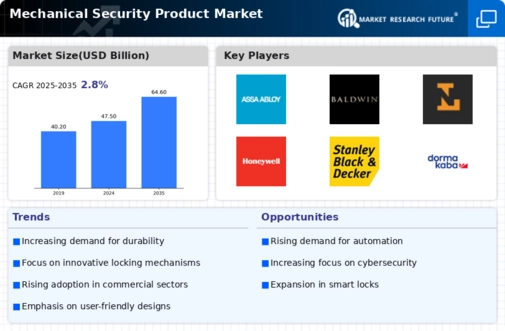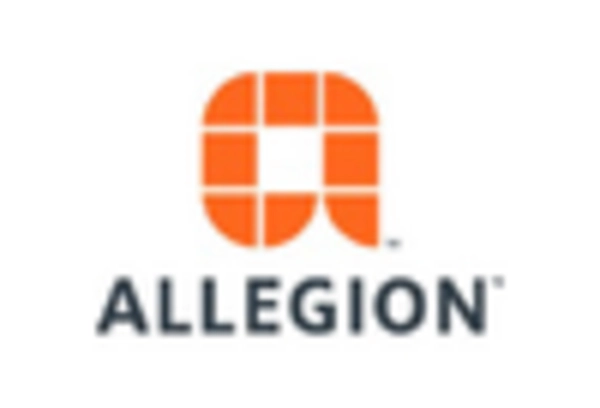Rising Security Concerns
The increasing prevalence of crime and security threats has heightened the demand for robust security solutions. As individuals and businesses seek to protect their assets, the Mechanical Security Product Market experiences a surge in demand. According to recent data, the market is projected to grow at a compound annual growth rate of 5.2% over the next five years. This growth is driven by the need for reliable security measures, including locks, safes, and other mechanical devices. The emphasis on physical security solutions is likely to remain strong, as consumers prioritize safety and protection against theft and vandalism. Consequently, manufacturers in the Mechanical Security Product Market are innovating to meet these evolving demands, ensuring that their products provide enhanced security features and durability.
Technological Advancements
Technological innovations are reshaping the Mechanical Security Product Market, leading to the development of more sophisticated security solutions. The integration of advanced materials and manufacturing techniques has resulted in products that offer improved strength and resistance to tampering. For instance, the use of hardened steel and anti-drill features in locks enhances their effectiveness against unauthorized access. Furthermore, the market is witnessing the emergence of hybrid products that combine mechanical and electronic security features, appealing to a broader range of consumers. This trend indicates a shift towards more versatile security solutions that cater to diverse needs. As technology continues to evolve, the Mechanical Security Product Market is expected to adapt, potentially leading to new product categories and increased competition among manufacturers.
Consumer Awareness and Education
There is a growing awareness among consumers regarding the importance of security, which is positively influencing the Mechanical Security Product Market. Educational campaigns and information dissemination about security risks have led to a more informed consumer base that prioritizes safety. As individuals become more knowledgeable about the various security options available, they are more likely to invest in high-quality mechanical security products. This trend is reflected in the increasing sales of premium locks and safes, as consumers seek products that offer enhanced protection. Additionally, the rise of online platforms for purchasing security products has made it easier for consumers to access information and compare options, further driving demand in the Mechanical Security Product Market. This heightened awareness is expected to continue shaping consumer behavior and preferences in the foreseeable future.
Regulatory Compliance and Standards
The Mechanical Security Product Market is significantly influenced by regulatory compliance and safety standards that govern security products. Governments and industry bodies are establishing stringent regulations to ensure that security devices meet specific performance criteria. This regulatory landscape compels manufacturers to invest in research and development to create products that comply with these standards. As a result, the market is witnessing an increase in the production of certified locks and safes that adhere to recognized safety benchmarks. Compliance not only enhances product credibility but also instills consumer confidence in the effectiveness of mechanical security solutions. Consequently, the Mechanical Security Product Market is likely to see a rise in demand for compliant products, as consumers and businesses prioritize safety and reliability in their security investments.
Increased Investment in Infrastructure
The ongoing investment in infrastructure development across various sectors is contributing to the growth of the Mechanical Security Product Market. Governments and private entities are allocating substantial budgets for the construction of commercial buildings, transportation hubs, and public facilities, all of which require effective security measures. This trend is particularly evident in emerging markets, where urbanization and economic growth are driving demand for security products. As a result, the Mechanical Security Product Market is likely to benefit from increased orders for locks, safes, and other mechanical security devices. The anticipated growth in infrastructure projects suggests a sustained demand for reliable security solutions, positioning manufacturers to capitalize on these opportunities in the coming years.


















Leave a Comment